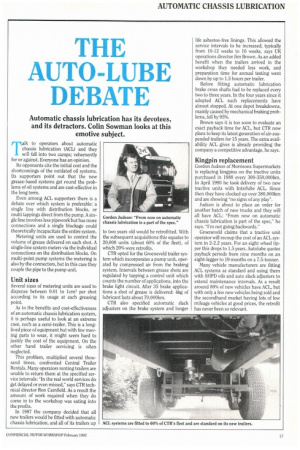THE AUTO -LUBE DEBATE
Page 93

If you've noticed an error in this article please click here to report it so we can fix it.
Talk to operators about automatic chassis lubrication (ACL) and they will fall into two camps; vehemently for or against. Everyone has an opinion.
Its opponents cite the initial cost and the shortcomings of the outdated oil systems. Its supporters point out that the new grease-based systems get round the problems of oil systems and are cost-effective in the long term.
Even among ACL supporters there is a debate over which system is preferable: a single line with distribution blocks, or multi tappings direct from the pump. A single line involves less pipework but has more connections and a single blockage could theoretically incapacitate the entire system.
Metering units are used to control the volume of grease delivered on each shot. A single-line system meters via the individual connections on the distribution blocks. On multi-point pump systems the metering is also by the connectors, but in this case they couple the pipe to the pump unit.
Unit sizes
Several sizes of metering units are used to dispense between 0.01 to 1 cm3 per shot according to its usage at each greasing point.
As to the benefits and cost-effectiveness of an automatic chassis lubrication system, it is perhaps useful to look at an extreme case, such as a semi-trailer. This is a longlived piece of equipment but with few moving parts to wear, it might seem hard to justify the cost of the equipment. On the other hand trailer servicing is often neglected.
This problem, multiplied several thousand times, confronted Central Trailer Rentals. Many operators renting trailers are unable to return them at the specified service intervals: "In the real world services do get delayed or even missed," says CTR technical director Ron Camfield. As a result the amount of work required when they do come in to the workshop was eating into the profits.
In 1987 the company decided that all new trailers would be fitted with automatic chassis lubrication, and all of its trailers up to two years old would be retrofitted. With the subsequent acquisitions this equates to 20,000 units (about 60% of the fleet), of which 20% were retrofits.
CTR opted for the Groeneveld trailer system which incorporates a pump unit, operated by compressed air from the braking system. Intervals between grease shots are regulated by tapping a control unit which counts the number of applications, into the brake light circuit. After 35 brake applications a shot of grease is delivered: 4kg of lubricant lasts about 70,000km.
CTR also specified automatic slack adjusters on the brake system and longer life asbestos-free linings. This allowed the service intervals to be increased, typically from 10-12 weeks to 16 weeks, says UK operations director Jim Brown. As an added benefit when the trailers arrived in the workshop they needed less work, and preparation time for annual testing went down by up to 1.5 hours per trailer.
Before fitting automatic lubrication brake cross shafts had to be replaced every two to three years. In the four years since it adopted ACL such replacements have almost stopped. At one depot breakdowns, mainly caused by mechanical braking problems, fell by 95%.
Brown says it is too soon to evaluate an exact payback time for ACL, but CTR now plans to keep its latest generation of air-suspended trailers for 15 years. The extra availability ACL gives is already providing the company a competitive advantage, he says.
Kingpin replacement
Gordon Judson of Morrisons Supermarkets is replacing kingpins on the tractive units purchased in 1988 every 300-350,000km. In April 1990 he took delivery of two new tractive units with Interlube ACL. Since then they have clocked up over 380,000krn and are showing "no signs of any play".
Judson is about to place an order for another batch of new trucks and they will all have ACL: "From now on automatic chassis lubrication is part of the spec," he says. "I'm not going backwards."
Groeneveld claims that a tractive unit operator will recoup the cost of an ACL system in 2-2.2 years. For an eight wheel tipper this drops to 1.5 years. Autolube quotes payback periods from nine months on an eight-legger to 19 months on a 7.5-tonner.
Many vehicle manufacturers are fitting ACL systems as standard and using them with SHPD oils and auto slack adjusters to extend maintenance intervals. As a result around 80% of new vehicles have ACL, but with only a few new vehicles being sold and the secondhand market having lots of low mileage vehicles at good prices, the retrofit has never been so relevant




































































































